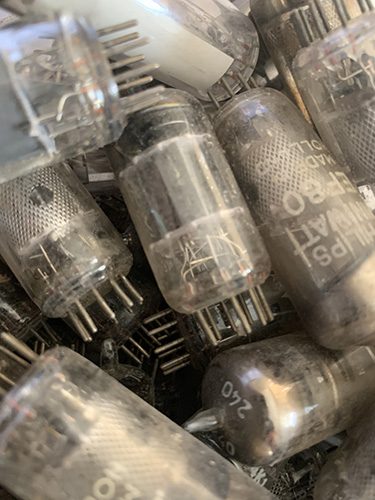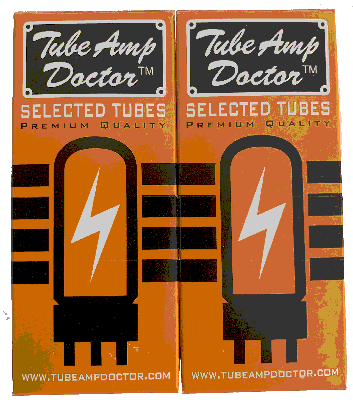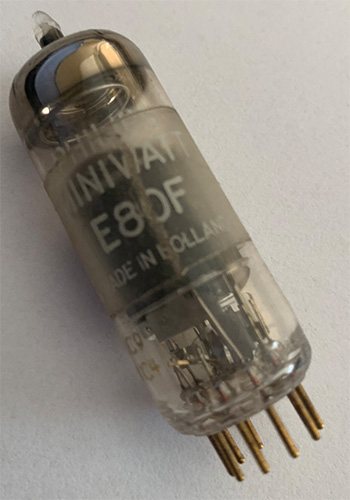 Tube types
Tube types
The European designation consists of letters followed by numbers. The letters indicate the voltage and the type of pipe. The numbers indicate the type of foot (contacts).
Commonly used types in guitar amplifiers according to the European designation are: ECC83, EL84 and EL34. The last 2 are power amplifier tubes.
First character |
Voltage or Ampere |
||
| A | 4 Volt | ||
| B | 180 mA | ||
| C | 200 mA | ||
| D | 1,4 Volt | ||
| E | 6,3 Volt | ||
| F | 12,6 Volt | ||
| G | 5 Volt | ||
| H | 150 mA | ||
| I | 20 Volt | ||
| K | 2 Volt | ||
| L | 450 mA | ||
| M | 1,9 Volt | ||
| N | 12,6 Volt | ||
| O | Without filament (cold cathode) | ||
| P | 300 mA | ||
| Q | 2,4 Volt. Powertube or transmission tube | ||
| R | "not used" | ||
| S | 1,9 Volt | ||
| U | 100 mA | ||
| V | 50 mA | ||
| X | 600 mA | ||
| Y | 450 mA | ||
| Z | Without filament (cold cathode) |
Next character(s) |
Type |
||
| A | Diode | ||
| B | Dubbeldiode met 1 kathode | ||
| C | Triode | ||
| D | Vermogenstriode | ||
| E | Tetrode | ||
| F | Pentode | ||
| H | Hexode of heptode | ||
| K | Octode | ||
| L | Eindbuis voor versterker | ||
| M | Kathodestraalbuis | ||
| N | Thyratron | ||
| Q | Enneode | ||
| S | Speciale buis | ||
| T | Telbuis | ||
| W | Vermogensdiode | ||
| X | Dubbele vermogensdiode | ||
| Y | Vermogensdiode | ||
| Z | Dubbele vermogensdiode |
Nummer(s) |
|
Feet / contacts |
| 1 - 9 | 5-pins en 8-pins | |
| 10 - 19 | 8-pins | |
| 20 - 29 | Loctal | |
| 30 - 39 | Octal | |
| 40 - 49 | Rimlock | |
| 50 - 59 | Speciale constructie | |
| 60 - 69 | Miniatuurbuis, geen pinnen | |
| 70 - 79 | Miniatuurbuis | |
| 80 - 89 | Noval | |
| 90 - 99 | 7-pins | |
| 100 - 119 | 8-pins | |
| 130 - 139 | Octal | |
| 150 - 159 | 10-pins | |
| 160 - 169 | 8-pins | |
| 170 -179 | 8-pins of 11-pins | |
| 180 - 189 | Noval | |
| 190 - 199 | Miniatuur 7-pins | |
| 280 - 289 | Noval | |
| 400 - 499 | Rimlok | |
| 500 - 599 | Magnoval | |
| 800 - 899 | Noval | |
| 900 - 999 | iniatuur 7-pins |
Special Quaility
Tubes of special quality (should last longer) were reversed after the first letter, number and subsequent letters. So, for example, a normal ECC82 would be called a quality tube E82CC.
I noticed that the quality tubes according to this code that I came across in my collection even had gold-plated pins. See, for example, the EF80 on the right, which is known as E80F.
I sometimes stick the transparent tape on tubes to prevent the white inscription from disappearing from the glass.
Matching
Tubes with corresponding properties can be selected on the basis of various measurements. A set is then formed of, for example, 2 or 4 tubes that share the same properties. After all, the enthusiast would like tubes of the same type also with identical criteria.
Obviously, such a "matched" set is more expensive to purchase than if you order individual copies.
See alongside the two boxes that are neatly attached to each other and contains two "tubes" that are "paired".

Manufacturer and production date
At the bottom of the glass, especially for European pipes, there is often a code with 3 or 4 characters.
This makes it possible to trace the manufacturer and the date of production.

